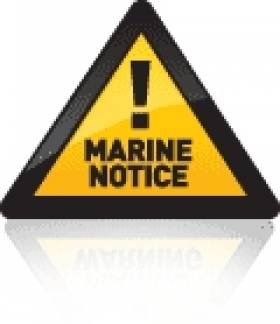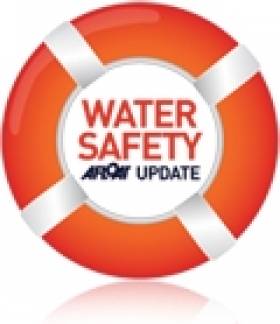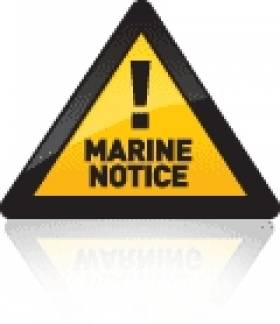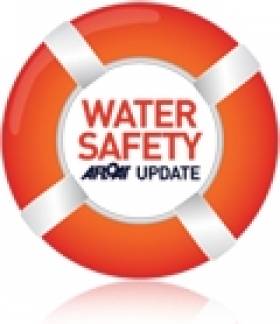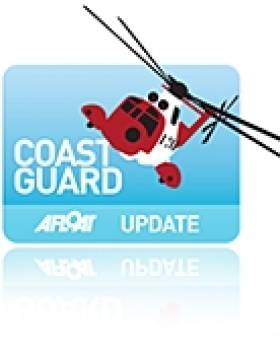Displaying items by tag: EPIRB
Important Safety Information for the Attention of Users of Emergency Position Indicating Radio Beacons
The Irish Maritime Administration of the Department of Transport, Tourism and Sport wishes to bring important safety information to the attention of users of Emergency Position Indicating Radio Beacons (EPIRBs).
The purpose of this notice is:-
• to highlight the importance of regular maintenance of EPIRBs by their owners;
• to highlight the obligation to register EPIRBs; and
• to advise users of certain GME EPIRBs that these have been the subject of a safety alert by the manufacturer.
It is vital for the safety of users of EPIRBs that you read and note the advice provided in the Marine Notices below which can be read on the Department's website at www.dttas.ie:
• Marine Notice No. 38 of 2013 which deals with the care and maintenance of EPIRBs, including the requirement for inspection and testing by owners. This Marine Notice also indicates that it is mandatory for all EPIRBs to be registered with the Irish Maritime Administration, and that changes to registered beacons must also be notified. If you own an EPIRB and have not yet registered it, or if you wish to notify any changes in ownership (or any other changes), please contact the Irish Maritime Administration as soon as possible. EPIRB registration is free of charge.
• Marine Notice No. 63 of 2013 which deals with a safety alert on GME EPIRBs. In the event of any EPIRB tested by the owner failing to produce a positive self-test result, owners should immediately contact their point of purchase or the manufacturer, or the GME email hotline at [email protected], as appropriate.
For any further enquiries please contact:
Maritime Services Division, Irish Maritime Administration, Department of Transport, Tourism and Sport, Leeson Lane, Dublin 2, Ireland.
Email: [email protected] . Telephone: 01-678 3400 (within Ireland) or +353-1-678 3400 (from abroad).
Emergency Position Indicating Radio Beacons – Statement by the Department of Transport, Tourism & Sport on
Following recent reports in the media regarding the use of Emergency Position Indicating Radio Beacons (EPIRBs) the Department of Transport, Tourism & Sport wishes to clarify the position regarding the approval and use of EPIRBs in Ireland.
Fishing vessels in Ireland are subject to a comprehensive survey regime covering all safety equipment, including the EPIRB, and a safety certificate is only issued on foot of satisfactory completion of the survey. EPIRBs and other safety equipment are regulated in accordance with the EU Marine Equipment Directive.
The GME EPIRBs, covered in media reporting and the subject of the manufacturer's recent safety alert, hold certification issued by Bureau Veritas, the relevant international certifying authority, confirming compliance with the EU Directive.
The Department as the national maritime authority raised concerns with the manufacturer earlier this year following feedback in relation to vessel surveys that led to the issue of the alert by the company. The manufacturer's alert emphasises the importance of all users testing the equipment at regular intervals in accordance with the alert notice. The Department also wishes to emphasise the importance of regular inspection and testing of all safety equipment in accordance with manufacturers' guidance.
In 2010 the Department made enquires of the manufacturer regarding false alerts and battery failures. The company advised at the time that they had four units returned to them from this country as part of their warranty process. In two cases the equipment had been replaced in line with the warranty. In a third case the warranty was refused because the equipment had been tampered with. The fourth EPIRB was still awaiting examination at the time.
The company has advised the Department that they have sold over 150,000 EPIRBs between 2004 and 2012 with a failure rate of 0.11%.
The Department is currently examining all the issues associated with this matter and will make a detailed report available as quickly as possible.
Radio Beacon Maker Learned Of Faults After Device Failure In Fishing Tragedy
#Safety - The factor of a malfunctioning radio beacon in the deaths of three fishermen in Tramore Bay this summer prompted the recent Marine Notice urging tests of such devices.
According to RTÉ News, the Australian manufacturer of the EPIRB devices in question was not aware of any problems until after it emerged that the beacon on the small fishing punt sailed by Paul, Kenny and Shane Bolger failed to emit a signal.
The bodies of the three men were recovered from the water in Tramore Bay just hours after they were reported missing on Wednesday 12 June.
The EPIRB - or Emergency Position Indication Radio Beacon - carried on the Bolger brothers' boat is one of the six classes identified in last week's Marine Notice (see appendix HERE).
All were manufactured between 2005 and 2010 by Australian film GME, which has since told RTÉ News that it lately learned of problems with its radio devices via "market-place feedback".
A malfunctioning microprocessor is thought to be to blame.
RTÉ News has more on the story HERE.
EPIRB Models Identified As Being At Risk of Failure – Marine Notice
Notice to all Shipowners, Fishing Vessel Owners, Agents, Shipmasters, Skippers, Fishermen, Yachtsmen and Seafarers
The Department of Transport, Tourism and Sport has been advised of potential GME EPIRB failures.
The following GME EPIRB models, manufactured in the 2005-2010 period, have been identified as being at risk of failure.
GME MT400, GME MT401, GME MT406G, GME MT401FF, GME MT403/G and GMEMT403FF/FG
Owners of all GME EPIRBs are advised to carry out immediate testing of their beacon as detailed in the annex to this notice.
For further information, please see the attached annex, which reproduces the safety alert on this matter, issued by GME.
Irish Maritime Administration,
Department of Transport, Tourism and Sport,
Leeson Lane, Dublin 2, Ireland.
11/11/2013
Marine Notice: Care And Use Of EPIRBs And Lifejackets
#MarineNotice - The latest Marine Notices from the Department of Transport, Tourism and Sport (DTTAS) remind all mariners of the importance of safety at sea - both in seeking help and staying safe till help arrives.
Marine Notice No 38 of 2013 details guidelines for the care and maintenance of Emergency Position Indicating Radio Beacons or EPIRBs, which if installed correctly will automatically operate if a vessel capsizes, notifying the nearest emergency services of your location.
Meanwhile, Marine Notice No 39 of 2013 informs all owners, charterers, masters, skippers and crew of fishing and commercial vessels that correctly selected and worn lifejackets or personal flotation devices (PFDs) save lives.
#coastguard – A man has been rescued nine miles off shore after he was thrown from his vessel and a signal from his personal locator beacon was picked up.
At 4.07pm last night Falmouth Coastguard contacted Milford Haven Coastguard about a signal from a PLB, (personal locator beacon) located nine miles offshore from St David's Head. Coastguard officers checked vessel and contact details on the UK Beacon Registry database and identified that this PLB was registered to the RIB (Rigid Hulled Inflatable Boat) Merlin.
Milford Haven Coastguard requested the launch of St Davids RNLI Lifeboat and the rescue helicopter from RAF Chivenor. The rescue helicopter located the man in the water using the signal from the beacon and winched him into the aircraft. The man was checked by the crew in the helicopter and in agreement with Milford Haven Coastguard returned to his vessel and has made the return voyage to Milford Haven.
The single handed skipper was on voyage from Milford Haven to Kilmore Quay in Ireland when a wave knocked him out of his RIB. He was thrown into the water but was wearing a survival suit, lifejacket and had a PLB with him. The man spent approximately three hours in the water.
Milford Haven Coastguard Watch Manager Rob James says:
"Fortunately this skipper was prepared for a single handed voyage offshore and having the right gear has saved his life. The kill cord on the vessel did work and cut the engine when he was thrown from the boat.
Wearing a survival suit and lifejacket enabled him to survive the three hours in the sea while awaiting rescue and the PLB which was activated sent the exact location of the casualty to the Coastguard."
Fatality Rate for Fishermen An 'Absolute Tragedy'
Fishermen and farmers make up more than half of all work-related fatalities in Ireland, according to the Minister for the Marine.
As The Irish Times reports, Simon Coveney TD decried it as an "absolute tragedy" in the Dáil.
He noted the progress being made in encouraging people to wear safety gear when on the water, but said there was "little or no progress in getting fishermen to wear lifejackets”.
"For some reason fishermen seem to think they will never fall in the water," the minister commented.
Cork South West TD Noel Harrington also raised the point of the Department of the Marine's refusal to use personal beacons that directly signal emergency services, rather than emergency position indicating radio beacons (EPIRB).
He referred to the capsizing of the Rambler 100 yacht in the Fastnet Race in August, saying that the latter did not go off to alert the coastguard as the boat had not sunk.
Wet, Shocked but Unharmed, Two Crew Plucked from Liferaft off Ardglass
At 4.40pm Belfast Coastguard were notified through MRCC Clyde that Falmouth Coastguard had received an EPIRB from the fishing vessel 'Islander' that was believed to be fishing in their area. Just afterwards Belfast Coastguard received reports of a flare and wreckage just of Ardglass, Northern Ireland.
Fishing vessel 'Golden Shore' went to investigate and found the Islander's two crew in a life raft. They were wet, shocked but unharmed.
Ian Murdock Belfast Coastguard Watch Manager said:
"Despite the dramatic and rapid loss of their vessel this crew were prepared for this eventuality. They were able to raise the alarm quickly and are tonight safe and well.
"This swift resolution of what could have been a life ending incident is the reason that we recommend that all vessels are fitted with an EPIRB which can automatically send a distress alert and, give an accurate position of your vessel to the Coastguard with through a satellite based rescue system
While it might be an exaggeration to say that all of the 21 crew members of Rambler 100 owe their lives to the Irish Search and Rescue service, there are certainly five people whose future prospects were greatly improved by the operation off the Fastnet Rock on August 15th. A lot of media focus has been on Coxswain Kieran Cotter and the crew of Baltimore Lifeboat as well as lifeboat mechanic Jerry Smith, whose dive boat, on charter to the media team of one of the competitors, was on hand to search and recover the five drifting crew. There is no question that this focus is appropriate. RNLI crews all over the UK and Ireland deserve the attention, not only because of their extraordinary voluntary dedication to the cause, but also because such publicity helps swell the coffers of the charity. The service could not operate without the generosity of the donors and incidents such as these help fill the blue boat-shaped boxes held by even more RNLI volunteers.

Saved: Ireland's Rescue Services Answered the Call of the capsized Supermaxi Rambler 100 off the Fastnet Rock. Photo: Team Phaedo
The dramatic stories and pictures dominating the media show the front line of a quite wonderful resource that is Search and Rescue in Ireland today. Baltimore Lifeboat was at the coal face of an intricate network of operations, triggered by the crew's EPIRBs. Irish Coast Guard radio officers in Valentia responded almost immediately tasking the rescue resources, working the phones and computers to confirm that this was not an accidentally triggered EPIRB, contacting RORC HQ, determining search patterns and relaying the information to the scene. It was the backroom contacts between RORC and the Coast Guard in endeavouring to contact Rambler 100 using satellite phones that confirmed the possibility of a catastrophic incident involving the Supermaxi. The subsequent tasking of the Shannon and Waterford based Sikorsky helicopters led to the medevac of crew member Wendy Touton and timely treatment of her hypothermic condition, initially by the on-board paramedics and later at Tralee General hospital. And Coast Guard involvement didn't end with the successful rescue – the shoreside operation to provide food and shelter in Baltimore was coordinated by Coast Guard personnel and the salvage operation of the hull of Rambler 100 was overseen by the Irish Coast Guard.

Rambler crew are recovered from the water after a SAR operation by the Irish Coastguard Photo: Team Phaedo. More photos here.
That Ireland has probably one of the best Search and Rescue services in the world goes back to the campaign initiated in 1988 by Joan McGinley, following the death, within sight of land of Donegal fisherman John Oglesby, whose leg was severed in a trawl winch. Eamon Doherty, the late former Garda Commissioner chaired the review group established in response to the campaign and his report led to the establishment of the Irish Marine Emergency Service, subsequently the Irish Coast Guard. Under the guidance of Director Capt Liam Kirwan, the new service moved quickly to become not only the central co-ordinating body for Search and Rescue, but developed its own resources, notably the helicopters, previously tasked in from Irish Air Corps and UK SAR.
Another element that will feature in the Rambler 100 incident is the Marine Casualty Investigation Board (MCIB), set up from recommendations arising from a review of the handling of investigations into marine casualties.
It might be thought that the incident is now closed, but there are many unanswered questions and the investigation will be looking at these and making recommendations that should improve safety in this sector. These questions will include EPIRB performance, liferaft deployment and grab bag usage, but perhaps the key issue yet to be determined is why the response from fellow competitors didn't appear to happen. Even if Channel 16 wasn't being actively monitored, and if not why not, shouldn't the Mayday set off by the Coast Guard have set off the DSC alerts on the radios of Rambler 100's fellow competitors? Had the incident occurred several hours later or earlier when Rambler 100 could have been up to 100 miles from the nearest land, when conditions worsened, we could be looking at much more serious consequences.
It is heartening to think that, in this small country of ours in troubled times, not only do we have a shining star in our search, rescue, recovery and restore system, involving professionals and volunteers cooperating for the greater good, we also have a system that determines the nature of incidents so that we can all learn from the experience.
And let us not forget those people and services, such as the Gardai, Navy, Army and the community of Baltimore who are outside the media spotlight who contributed to this happy ending.
Afloat's Latest Coastguard News
Afloat's Latest RNLI Lifeboat News
Afloat's Latest MCIB News
Flares No Help to Mayo Fishermen Stranded at Sea - MCIB Report
Two Mayo fishermen stranded at sea after their boat capsized were not assisted after they used flares, a Marine Casualty Investigation Board (MCIB) report has found.
The report, released earlier this week, recounted that the 33m crabber Léim an Bhradán had set out from Porturlin in Ballina on the morning of Saturday 30 October last on a routine fishing trip to retrieve and reset crab and lobster pots some 12 to 15 miles offshore.
The vessel was manned by skipper John O’Donnell, aged 18 at the time, and crew Nathan Flannery, in his 20s, both young men but with many years of fishing experience between them.
At some time between 1pm and 1.45pm, after having successfully hauled and re-shot one tow of pots, a second tow, in the process of being hauled, was partially aboard being emptied and re-baited.
The vessel was listing slightly to starboard due to the pots being hauled over that side when a large wave broke over the starboard quarter and flooded the working deck.
This caused the vessel to list further to starboard, allowing more water over the side and causing the stacked pots and boxes to shift, increasing the angle of the list and throwing both men into the water before the boat capsized and sank rapidly.
The boat's canister-type liferaft, which was not secured to the vessel but stored in a cradle on top of the wheelhouse, floated to the surface with a life ring. O’Donnell and Flannery managed to inflate the raft and climb aboard around 2pm, after some difficulties in operating the gas inflation cannister and releasing the raft from its securing straps.
The men then opened the SOLAS B equipment pack stored on the liferaft and released two parachute flares, 20 minutes apart, with no response. At around 3pm the pair spotted an Irish Coast Guard helicopter and released an orange smoke signal, but the chopper did not respond. It later transpired that this aircraft was the Sligo-based coastguard helicopter on a training exercise.
Several hours later, the alarm was raised ashore when the Léim an Bhradán had not returned to port. A rescue helicopter and lifeboat were tasked to the scene before midnight and the liferaft was located just after 1.30am.
O’Donnell and Flannery, who had earlier donned thermal suits to protect from the cold, were picked up and brought ashore by the lifeboat. Neither was injured in the incident.
The MCIB report found that had the lifeboat been secured to the vessel, it would have been in a position to inflate correctly as per its design.
It also found that had the EPIRB emergency beacon been mounted to a 'float free' bracket outside the wheelhouse, rather than stored inside, it would have floated to the surface and activated automatically, notifying the coast guard immediately.
Neither skipper nor crew was in possession of the boat's handheld VHF set, the report noted, which hampered their ability to contact any nearby vessels for assistance.


























